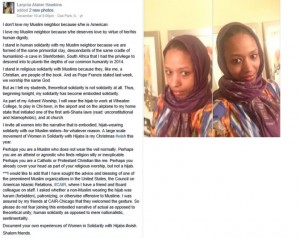It’s been established by now that Dr. Hawkins’ assertion that Muslims and Christians worship the same God hardly falls outside the mainstream of orthodox evangelical theology—a point Dr. Hawkins reiterated in a widely circulated letter to Wheaton’s provost.
With some irony, however, I would like to note how Dr. Hawkins’ Advent Facebook post actually did make at least one claim that contradicts Wheaton’s Statement of Faith. It doesn’t have anything to do with whether Christians and Muslims worship the same God, though, and for reasons I’ll explain below, it seems doubtful that Wheaton will ever publicly raise the issue.
In that post [image above left] Dr. Hawkins wrote:
I love my Muslim neighbor because s/he deserves love by virtue of her/his human dignity. I stand in human solidarity with my Muslim neighbor because we are formed of the same primordial clay, descendants of the same cradle of humankind—a cave in Sterkfontein, South Africa that I had the privilege to descend into to plumb the depths of our common humanity in 2014.
At first glance, this statement seems to be a simple affirmation that Christians and Muslims share a common humanity—something that not even truly hard-boiled fundamentalist theologians could easily deny. In her second sentence, however, Dr. Hawkins employs a bit of unique argumentation—specifically, by making reference to a cave system in South Africa called Sterkfontein.
The Sterkfontein cave network is part of an archaeological dig site declared a World Heritage Site by UNESCO in 1999. Since the 1930s many early hominid fossils have been uncovered at Sterkfontein, including several complete or nearly complete skeletons. The interesting thing about these fossils, however, is that they are not the remains of our own hominid species, homo sapiens. Rather, the fossils uncovered at Sterkfontein are from other early hominid species—some of whom are now believed to be our closest pre-human ancestors. Thus Dr. Hawkins’ reference to Sterkfontein as the “cradle of humankind.”
But, while Sterkfontein does powerfully illustrate humanity’s common origins, Dr. Hawkins’ statement about it—because it implicitly asserts the truth of scientific human evolution—actually runs afoul of the anti-evolution clause in Wheaton’s Statement of Faith, which reads:
WE BELIEVE that God directly created Adam and Eve, the historical parents of the entire human race; and that they were created in His own image, distinct from all other living creatures, and in a state of original righteousness.
This passage from Wheaton’s creed is packed with buzzwords and coded language borrowed from the lexicon of evolution-denying young earth creationism. Among many evangelicals, to say that God “directly created Adam and Eve” is actually a coded denial that human beings were produced through evolutionary processes—even if these were guided by God’s providence, as in the Christian concept of intelligent design. At the same time, to insist that Adam and Eve are humanity’s “historical parents” excludes any allegorical or mythical interpretation of Genesis’ creation narrative.
Not only did Wheaton’s creed not acquire this anti-evolution language until the mid-century’s evangelical culture wars, but, what’s more, its continued presence in the college’s official Statement of Faith (along with on-campus institutes like the Billy Graham Center) helps Wheaton vouch for its own conservative bona fides. This is the case in spite of the fact that Wheaton—like most other reputable Christian colleges—does teach the science of human evolution in its biology classrooms (though, when compared to other elite Christian schools like Pepperdine University and Calvin College, Wheaton is alone in explicitly touting the “limitations of biology as a scientific endeavor” on its biology department’s webpage).
In fact, coded language like this is actually a key part of how Wheaton operates as it seeks to balance its academic ambitions with the demands of its core constituency on the evangelical right. At the same time, however, this leaves Wheaton divided between two very different institutional identities and cultures—it’s not easy, after all, to cultivate a reputation for top-flight scholarship while simultaneously signaling common cause with evolution-denying right-wing conservatism.
Given the emptiness of Wheaton’s theological censure of Dr. Hawkins, it seems even more unlikely that Wheaton’s move to fire Dr. Hawkins is a principled defense of evangelical orthodoxy. In fact, it seems fair to presume that the optics of this situation are deliberate—Dr. Hawkins’ censure has all the marks of a carefully crafted dog-whistle meant to confirm, for Wheaton’s conservative Christian observers (and erstwhile critics) on the political far right that Wheaton shares their offense at a Christian college professor publicly advocating solidarity with Muslims.
Far from being a PR disaster, Wheaton’s treatment of Dr. Hawkins was intended all along to broadcast the college’s displeasure at the sight of a black woman wearing a hijab in one of its classrooms—a strategy, we should all take note, that in the end will have worked whether or not Larycia Hawkins keeps her job.






